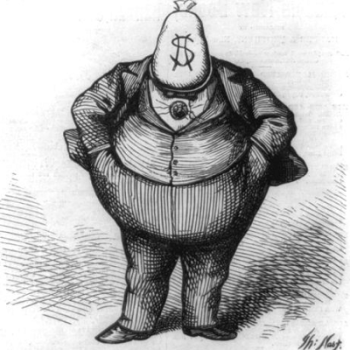This White House memo, dated Oct. 25, 2001, shows the difficulty that President Bush’s staff were having in trying to explain to their boss the ramifications of his plan to “privatize” Social Security.
Discussing this memo, Matthew Yglesias offers a pithy summary of the crux of the problem with this scheme:
The basic dilemma facing any would-be privatizer is that under the present system, a worker’s payroll taxes pay not for his retirement but for that of current retirees. Under a privatized system, your taxes would be diverted into an account that would be invested and from which you would draw your pension. Any attempt to switch between the systems, then, finds a current worker’s tax dollars being promised both to the worker and to today’s retirees. The only way to finance the transaction is with benefit cuts, tax increases, or some combination of the two.
President Bush’s plan is exactly this kind of “attempt to switch between the systems,” and thus, as Matt says, “finds a current worker’s tax dollars being promised both to the worker and to today’s retirees.”
It is hard to guess whether or not President Bush understands this. Kent Smetters, the senior official in Bush’s Treasury Department who drafted the memo above, seems to think that Bush does not understand this. And Smetters does not seem optimistic that he will be able to make the president grasp this simple point.
But Smetters may be misunderestimating his boss. It may be that Bush fully understands that his privatization plan is a Moebius strip, a snake swallowing its own tail, a logical and mathematical impossibility. But if he does understand this then he apparently is banking on the likelihood that the American people do not. He may not be the dim pupil that Smetters imagines him to be, but rather a brilliant quick change artist.
The quick change is usually a small-time con practiced on cashiers and grocery clerks. It’s never done exactly the same way twice, but the basic outline is something like this:
You’re a cashier. I’m the fourth or fifth person in a long, impatient line and I’m buying something small — something that costs around $6. All I’ve got is a twenty, so I give you that and you start to make change — a ten and four ones. Oh, but wait, I’ve also got a $1 bill. I pull that out of my wallet and suggest that you just give me $15 dollars in change.
So far, so good, but here’s where it gets confusing. This is the part that, afterward, you won’t be able to reconstruct quite clearly as you and your boss try to figure out why your cash drawer is $20, or $30, or $36 short. It may be that I decide to buy some other small thing — a pack of gum at the counter. Or maybe I need small bills for the machine, or to pay for parking or a cab. There may even be a phone number on the back of that twenty and I need that number so I trade you back for it with something like $20 in smaller bills. But eventually I’m going to walk away from that counter with my $20 back in my wallet, plus the $1 that I never quite gave you, plus the change from the $10 which used to pay for the merchandise I’ve just purchased from you with your own money, plus another $10 that you gave me because … because … well it made sense at the time.
The quick change artist is an expert at spending the same money for many different things at the same time. And it’s not even his money.
… under the present system, a worker’s payroll taxes pay not for his retirement but for that of current retirees. Under a privatized system, your taxes would be diverted into an account that would be invested and from which you would draw your pension. Any attempt to switch between the systems, then, finds a current worker’s tax dollars being promised both to the worker and to today’s retirees.
Same con. Much higher stakes.












